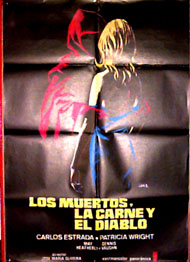 Maria Oliveira worked in the film industry as the local director of the William Morris Agency. He oversaw the Spanish distribution of films such as "Lawrence of Arabia." He was introduced to the Church through his wife, American actress Patricia Wright.
Maria Oliveira worked in the film industry as the local director of the William Morris Agency. He oversaw the Spanish distribution of films such as "Lawrence of Arabia." He was introduced to the Church through his wife, American actress Patricia Wright.
After joining the Church, Oliveira went on to write, produce and direct at least two major Spanish films: "Los Muertos, la carne y el diablo" (1974) and "Las Flores del miedo" (1973). Both of these were horror films starring Patricia. Interestingly enough, both films incorporated Gospel themes, and one even included Latter-day Saint missionaries. Together these two films grossed nearly 10 million pesetas at the box office.
Church history in Spain website:
Regular Chruch services began in Spain among LDS servicemen after World Ward II when the United States established relations with that country. Two American branches were functioning in 1966, and a district presidency operated under the French Mission. One of the first converts in Spain, José María Oliveira, was baptized in France in March 1966...Spain's first stake was created in madrid on March 14, 1982, with José Oliveira as president. Additional stakes followed. When the Seville Spain Stake was created in 1988, one area within the stake reported 98 percent activity among Melchizedek Priesthood holders, and noted that 54 members of the stake were serving full-time missions...
in 1967, legislation was passed that made possible the recognition of non-Catholic churches. This led to the call of local missionaries from the Madrid servicemen's branch of the Church. Elders Rodney Dotson and José María Oliveira were two of these early missionaries. (José María Oliveira was later to be called as the first president of the Madrid Stake.) Slowly, the Spanish membership of the Church grew. In 1968, the Madrid Spanish Branch was organized, with José María Oliveira as the first counselor to President David B. Timmins. The first meeting -- a Sacrament meeting -- of the new branch was held on Feb. 4, 1968 in downtown Madrid. Thirty-eight members attended.
E deseo de la Iglesia de instaurar ramas autoctonas en Espana no se vio cumplido hasta 1967. La posguerra, y la condena de las democracias occidentales al régimen del general Franco, causo la famosa época de aislamiento o autarquía en Espana, durante la cual, a pesar de la no libertad religiosa, la Iglesia envio algunos donativos de su Plan de Bienestar.Cuando El Presidente Eisenhower restablecio las relaciones Espana-EEUU, dos ramas extranjeras empezaron a funcionar en nuestro país, compuestas por empleados, diplomaticos y militares mayormente norteamericanos.
En este contexto, en 1966, se bautizo José María Oliveira, el primer pionero de la Iglesia en Espana (se habían bautizado antes otros espanoles residentes en el extranjero). Oliveira había conocido la Iglesia por su esposa, la estadounidense Patricia Wright, y procedía del mundo del cine (era el director de la Agencia William Morris, que representaba en Espana a los actores de Hollywood, y había participado en el reparto de películas rodadas aquí, como "Lawrence de Arabia").
La Ley del 67 reconocía el libre ejercicio de las iglesias ya existentes en Espana, lo cual incluía a La Iglesia de Jesucristo de los Santos de los Ultimos Días.
En 1970 se organizo la primera mision espanola, y en 1974 había 17 ramas, con líderes nativos, y con 619 miembros. En 1975 la hoy Reina de Espana, dona Sofía, asistía al concierto de un coro de la Iglesia en el Auditorio del Centro Superior de Investigaciones Científicas, junto a los presidentes de mision, y al Presidente Oliveira.
Filmography source: Internet Movie Database. Web page created 10 September 2001.